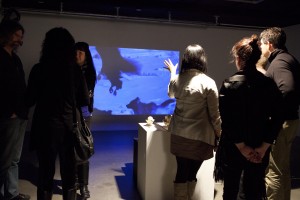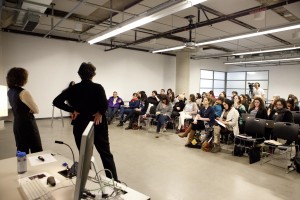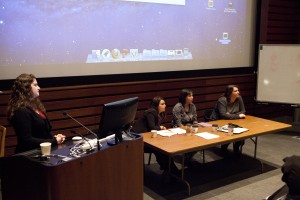
TRANSMISSIONS: Symposium Overview
February 28 marked the first day of a three-day symposium on contemporary Indigenous film, media arts and exhibitionary practice, TRANSMISSIONS: Sharing Indigenous Knowledge and Histories in the Digital Era. Through workshops, a film screening, an interactive art installation and a public symposium, Concordia students and faculty joined the Canadian Aboriginal creative and intellectual community in a dialogue on sharing Indigenous knowledge and histories in the digital era. This workshop was a production of Concordia’s CEREV lab, organized by Department of Art History faculty member and CEREV affiliate Heather Igloliorte, and generously sponsored by CEREV, the Department of Art History, the Faculty of Fine Arts, the Gail and Stephen A. Jarislowsky Institute for Studies in Canadian Art, the Inuit Art Research Group, and AbTec (Aboriginal Territories in Cyberspace).
On Thursday, February 28, Alethea Arnaquq-Baril presented a workshop on her work in progress, Angry Inuk in which she examines how the impact of the global animal rights movement and the boycott of seal products on the Inuit of the Canadian Arctic, who depend on the seal for food and income.
On Friday March 1, Ruth Phillips gave a talk titled Museum Utopias, Museum Dystopias: The Dawning of the Age of Hybridity and the Canadian Museum of History in which she discussed changes in the museum world, and the need for promoting hybridity by providing new kinds of contexts in exhibitions, supporting collaborative processes, and blurring the typologies of the museum systems. Phillips discussed different approaches by museums to decolonize museum practices and accepting multiple alternative perspectives.
Following the Phillips’ discussion, Alethea Arnaquq-Baril presented her documentary Tunniit: Retracing the Lines of Inuit Tattoos in which she documented her personal journey to revive the ancient tradition of Inuit face and body tattooing. The film culminated with her decision to get her own traditional tattoos. For the artist, exploring these aspects of Inuit culture was a part of a healing process, as well as a continuation of her culture.
At six in the evening, Jordan Bennett presented his installation Skull Stories. In his interactive sculpture, Bennett used plastic casts of four animal skulls – bear, coyote, rabbit, and beaver – with USB ports that initiated a short film related to each animal when plugged in. There was an interesting connecting between Bennett’s work and Alethea Arnaquq-Baril, because while each artist commented on the importance of the connection to the land and its animals, Bennett’s sculpture asks the visitors to literally connect with the animals by plugging in a cord into each skull in order to access the knowledge each animal possesses.
On Saturday March 2, Heather Igloliorte welcomed all speakers and guests at 9am. The symposium got underway with the first panel discussion entitled Current and Continuous: Indigenous Knowledge and High-Tech Media Arts moderated by Amber Berson. Jason Edward Lewis, Skawennati and Scott Benesiinaabandan talked of the importance of collaboration and community connections. The three speakers stressed the importance of educating Aboriginal people in digital media production, as a way of telling old stories with new media and as an expression of the continuity of culture.
The second panel was titled A New Language: Creating and Exhibiting Indigenous Visual Culture in the Digital Era, moderated by Carla Taunton. Ryan Rice, Jordan Bennett and Steven Loft discussed new media as the language for preserving traditions and languages, and the need for Aboriginal artists, curators and writers to reclaim and rewrite their stories.
After a lunch break, the symposium resumed with the third panel, Indigenous Rights and Activism: Museums, Film and Media Arts, moderated by Monica Patterson. Tricia Logan (http://humanrightsmuseum.ca/home), Alethea Arnaquq-Baril and Julie Nagam stressed the need to decolonize the way Indigenous peoples are seen and presented in galleries and museums, and to move beyond the binaries of traditional versus contemporary, colonized versus colonizer, in order to move towards an acceptance of multiple worldviews and beliefs.
The final panel, Indigenizing the Archive: The Aboriginal Art History Project, was hosted by the Aboriginal Curatorial Collective. Sherry Farrell Racette, Jason Baerg, Cathy Mattes, Guy Sioui-Durand and Dayna Danger discussed the necessity of building an Aboriginal art archive that is not modelled on the Western paradigm of the linear progression of ‘genius’, the need for interaction and collaboration, and moving beyond thinking of the archive as a physical space. TRANSMISSIONS explored the interface of Indigenous knowledge and oral history with digital technologies, experimental museology, and new communicative forms in twenty-first century exhibition and artistic practice.
Post By Zofia Krivdova






